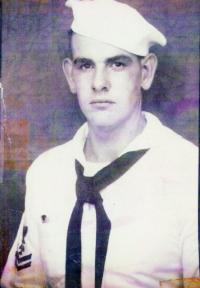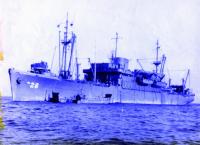
Fireman Second Class Nathanael L. Henry (rt) & Reese McCleeve (UDT team) onboard USS Charles Carroll Apa 28.

Author's father, Nathanael L. Henry, crewman aboard a landing craft, cited for bravery during Sicily Invasion.

USS Charles Carroll Amphibious Transport Apa 28: note LCPL's alongside (Landing Craft Personnel Launch).
The Invasion of Sicily was the first time the Allies had set foot on Hitler’s Fortress Europe. It led to the deposing of Benito Mussolini and his eventual execution. Further, it took Italy out of the war and history now shows this invasion marked the beginning of the end of the Second World War in Europe.
The Sicily Invasion took place on July 9, 1943. It was a nighttime operation with one major complication, which was the weather - 40 mile per hour winds. These winds played havoc with the invasion force of 144 Gliders laden with British Paratroopers and equipment. Twelve made it to their assigned landing areas, while 69 crashed in the sea. Young pilots in the C-47's burdened with very complex flight plans and gale force winds carrying paratroopers from the 82nd Airborne and 505th Airborne became disoriented. Upon making their jumps, the paratroopers were scattered as far as 25 miles from their drop sites.
Despite these problems the British and American troops formed up in small groups and started their part of the invasion where they landed. As the German and Italian troops expected no invasion, due to the weather, they were caught entirely by surprise. The Paratroopers caused mass confusion behind the enemy lines, which played an important part in the successful invasion operation.
The amphibious landings were an entirely different matter, due to the bravery and expertise of the small boat handlers - both U.S. Navy and Coast Guard. The crews participating in the landings got all their troops to their assigned beaches without the loss of a single man or boat, a remarkable feat considering these maneuvers were carried out at night in 15-foot seas. I'm proud to say my Dad was one of these men.
The North African campaign was nearly ended, which basically meant it was a mop-up operation, when President Franklin Roosevelt, British Prime Minister Winston Churchill and their senior military advisors met in Casablanca, Morocco, in January 1943, to plan a military strategy for the coming year. The leaders of both nations decided that Sicily would be their next operation. The British welcomed the decision as it would open the sea lanes to the Eastern Mediterranean and give the Allies a base of operations for future offensive action. American General George C. Marshall dissented, and argued the Allies should focus on a direct thrust at Nazi Germany and not waste time with peripheral Axis outposts, such as Sicily.
The overall commander of the operation was General Dwight D. Eisenhower Commander-in-Chief of Allied Forces North Africa. British General Sir Harold Alexander was his second-in-command. Major-General Walter Bedell Smith was appointed Chief-of-Staff. The overall Naval Force was commanded by British Admiral Andrew Cunningham. The Land Forces were structured into two Task Forces. The Eastern Task Force was led by General Bernard Montgomery and consisted of the British Eighth Army. The Western Task Force was commanded by General George S. Patton and consisted of the 7th United States Army. Naval Forces consisted of two Task Forces - the Eastern and Western. The Eastern Task Force was led by Admiral Sir Bertram Ramsay and the Western by Admiral H. Kent Hewitt. Air Operations were organized as the Mediterranean Air Command, or MAC, under Air Chief Marshal Sir Arthur Tedder. Air assets were supplied by the US 12th Air Force, 9th Air Force and the British Royal Air Force.
The Island was defended by two Corps of the Italian 6th Army under General Alfredo Guzzoni. Axis Forces totaled roughly 200,000 Italian and 32,000 German Troops, and 30,000 Luftwaffe ground staff. The main German formations were the Hermann Göring Panzer Division and the 15th Panzer-Grenadier Division. The Hermann Göring Division had 99 tanks, but was short on infantry. The panzer-grenadier division had 60 tanks.
As with all invasions planned by the Allies, deception was a prime, and exceedingly important, part of the operation and the Sicily Invasion was no exception. Perhaps the most famous of all deceptions was Operation Mincemeat.
British Intelligence dressed a corpse in the uniform of a British Officer with an attaché case handcuffed to his arm and released the corpse off the coast of Spain to drift to the Spanish shoreline. Inside the attaché case were forged Military Documents revealing the plans of an Allied invasion of Sardinia and Greece - with no plans to invade Sicily. To add to the deception, notes were included in the attaché case from the "Officer’s" girlfriend. The deception worked. The corpse floated ashore at Punta Umbria, Spain. The body was removed and searched, and the papers found their way to German Intelligence and later to Hitler himself. Hitler was convinced there would be no invasion of Sicily, while Benito Mussolini argued vehemently the invasion would land on Sicily's shores. However, Hitler's wishes took precedence and special fortifications or defenses were not bolstered on the island beaches. Because of Operation Mincemeat, Hitler was so convinced the Allies would not invade Sicily, he only left two divisions to protect the Island. Even several days into the invasion, he was certain it was a diversionary tactic.
On the night of July 9, 1943, the invasion of Sicily was launched. The Allied armada contained some 2,590 ships - the largest fleet ever assembled for an invasion. General Guzzoni knew that the invaders had to be stopped on the beaches or the Axis would have a hard time holding Sicily. However, Field Marshal Albert Kesselring, Commander of the German Army in Italy, committed a major blunder by not following General Guzzoni's orders to concentrate on the beaches. Kesselring, instead, transferred his troops as a reserve in Western Sicily ready for a counterattack where they were of no use in an invasion.
Shortly before 3:00 A.M. on July 10, Allied Forces jumped off to begin the invasion under severe weather conditions, with winds reaching 40 mph and seas running 15 feet high. Airborne Glider and Parachute Troops preceded the seaborne invasion troops. All were disrupted by the intense winds, but managed to successfully complete their missions. The landing Troops were scattered all along the Sicilian Coast, but not one man was lost due to the weather and the dark of night. All boats returned to their ships. Due to the poor defenses on the beaches and lack of enemy troop strength, the Allies had very little problem establishing a beachhead and moving inland. Of course, Allied bombing and bombardment played an important roll in this endeavor.
During the three days of the invasion, the US Army and Navy moved 66,285 personnel, 17,776 tons of cargo, and 7,396 vehicles over Sicily's Southern Shores. Not to be forgotten was the use of the relatively new LSTs, LCTs, LCVPs and DUKWs that would prove invaluable in the D-day Invasion and further invasions in the Pacific Theater.
The invasion of Sicily was the first time a complete U.S. Field Army - the 7th Army, comprising 200,000 men - had operated as one unit. The U.S. showed the ability to partner with the British in a combined Allied Air, Sea, and Land operation that met with total success. This invasion was an important training ground for the Allied Invasion of Normandy, 11 months later.
Sicily was the first Axis home territory to fall to Allied Forces in World War II. The Allied advances led to the destabilization of the Italian Government and Benito Mussolini's ousting. Although this did not end Italy's active participation in the war, it sounded its death knell. Morale was high as Allied Forces touched ground on Fortress Europe, the beginning of the end of World War II in Europe.
For the next five weeks the Allies advanced with General George Patton's Army moving to the Northwestern shore, then East toward Messina protecting the flank of General Montgomery's veteran troops, while they moved up the East Coast of the Island. The Italian Fascist Regime was so rocked by the invasion, that on July 24, 1943, Prime Minister Benito Mussolini was deposed, arrested and later shot and hung in the streets of Milan, with his girlfriend, Clara Petacci. As the Allies hoped, a new regime came into power led by Marshal Pietro Badoglio who opposed the Nazi alliance with Italy and immediately began secret talks with Allies for an Armistice.
The day after Mussolini's arrest, Italian troops began withdrawing from Sicily. Hitler advised his Army to make contingency plans for withdrawal but to fight fiercely against the Allied advance. From July into August, General Patton and General Bernard Montgomery's forces began pushing the Axis Troops off the Island and had most of the Axis troops trapped in the Northeast corner of the Island. The end of the battle for Sicily was bitter sweet. Over several nights German and Italian troops numbering nearly 100,000 along with their vehicles, equipment and ammunition were evacuated from the Island, crossing the Strait of Messina to the Italian Mainland. When Patton moved into Messina he was surprised to find no opposition. The Battle was over, but the German losses had not been severe and the Allies were unable to capture the escaping army, undermining the victory while making it more problematic for the Allies when they attacked the Italian Mainland.
In the 38 days of combat the Allies inflicted more than 29,000 casualties and captured 140,000. The Americans suffered 2,237 KIA and 6,544 wounded or captured. The British suffered 12,843 casualties, including 2,721 killed in action. The Allies lost 274 aircraft while the Axis lost 1,691.
NEXT WEEK: HAMBURG
«Go back to the previous page.


